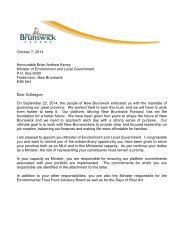cbd-ts-67-en
cbd-ts-67-en
cbd-ts-67-en
- No tags were found...
You also want an ePaper? Increase the reach of your titles
YUMPU automatically turns print PDFs into web optimized ePapers that Google loves.
Section 2: Strategies to Address the Chall<strong>en</strong>ge of Marine Debris<br />
in municipal recycling programs. One of i<strong>ts</strong> curr<strong>en</strong>t objectives is to implem<strong>en</strong>t the collection and recycling of<br />
more plastic packaging (Continuous Improvem<strong>en</strong>t Fund, Waste Diversion Ontario).<br />
Taxes have be<strong>en</strong> put on disposal at landfill sites to increase the cost to users, to better reflect the true life-cycle<br />
cost of disposal, and to drive waste materials into recycling systems. The United Kingdom established such a tax<br />
in 1996, and it is curr<strong>en</strong>tly (2012) charged at a rate of GBP 64 for each tonne disposed. Such disposal surcharges<br />
have be<strong>en</strong> used to g<strong>en</strong>erate rev<strong>en</strong>ues for public authorities, which can th<strong>en</strong> be used to support a variety of waste<br />
diversion initiatives. Rev<strong>en</strong>ues could be used to promote reduction in the g<strong>en</strong>eration of material frequ<strong>en</strong>tly<br />
found in marine debris and for marine debris remediation.<br />
2.6.3 Bans and p<strong>en</strong>alties<br />
Bans on disposal at landfill sites have be<strong>en</strong> used to support some EPR programs such as those for electronics<br />
and other programs targeting types of construction materials. They have not g<strong>en</strong>erally be<strong>en</strong> used in the area<br />
of packaging because the practicalities of <strong>en</strong>forcem<strong>en</strong>t can be chall<strong>en</strong>ging, ev<strong>en</strong> in situations where regulatory<br />
and <strong>en</strong>forcem<strong>en</strong>t capacities are well established.<br />
P<strong>en</strong>alties for lack of performance of a producer responsibility program or failures to meet regulatory requirem<strong>en</strong><strong>ts</strong><br />
of any kind are common in most legislation governing waste managem<strong>en</strong>t and waste diversion. Application of<br />
such p<strong>en</strong>alties is rare except in the most notable of cases, but the fact that such a p<strong>en</strong>alty could be applied can<br />
serve to help drive program performance. In order to institute any kind of p<strong>en</strong>alty, regulated programs must<br />
have clear performance requirem<strong>en</strong><strong>ts</strong> and be subjected to indep<strong>en</strong>d<strong>en</strong>t auditing. Compliance promotion is also<br />
necessary in advance of any legal action.<br />
2.7 RESOURCES, NOT WASTES<br />
End-of-life managem<strong>en</strong>t of produc<strong>ts</strong> and packaging has traditionally focused on the ease and conv<strong>en</strong>i<strong>en</strong>ce<br />
of disposal, and only secondarily on materials recovery and recycling. Compreh<strong>en</strong>sive municipal recycling<br />
programs in OECD countries are heavily dep<strong>en</strong>d<strong>en</strong>t on sustainable marke<strong>ts</strong> for collected materials. With<br />
increasing demands for commodities in the global market place many <strong>en</strong>d-of-life produc<strong>ts</strong>, including plastics<br />
and packaging, are increasingly being se<strong>en</strong> as sources of valuable secondary materials which are lost forever if<br />
disposed of. At the same time, the recycling of secondary materials has be<strong>en</strong> docum<strong>en</strong>ted to have positive GHG<br />
impac<strong>ts</strong> in contrast to landfill disposal (US EPA, 2012).<br />
The OECD had focused considerable att<strong>en</strong>tion on the issue of secondary materials through i<strong>ts</strong> sustainable<br />
materials managem<strong>en</strong>t (SMM) initiative. SMM is se<strong>en</strong> as the framework within which more targeted waste<br />
and recycling policies and programs could be implem<strong>en</strong>ted. According to the OECD, “sustainable materials<br />
managem<strong>en</strong>t proposes a shift from policies focused on isolated aspec<strong>ts</strong> of the material chain, causing leakages<br />
and unint<strong>en</strong>ded side effec<strong>ts</strong>, to an integrated policy approach that embraces the full life cycle of produc<strong>ts</strong> and<br />
materials.” It is also suggested that “there is a large pot<strong>en</strong>tial for diverting waste from landfills, for stepping up<br />
recycling and for more <strong>en</strong>vironm<strong>en</strong>tally sound managem<strong>en</strong>t” (OECD, 2010).<br />
The OECD recognizes that <strong>en</strong>hancing recovery of materials is important, but also notes that the effici<strong>en</strong>t and<br />
sustainable use of materials has to improve as well. Both of these objectives speak to the opportunities available<br />
to reduce the amount of plastics and packaging waste that escapes recovery, may be improperly disposed of,<br />
and pot<strong>en</strong>tially <strong>en</strong>ds up as marine debris.<br />
Similarly, the UNEP Marrakesh 10 Year Framework for Sustainable Consumption and Production has focused on<br />
life cycle approaches to support i<strong>ts</strong> goals for gre<strong>en</strong>er economies and gre<strong>en</strong>er business models, with att<strong>en</strong>tion on<br />
integrated waste managem<strong>en</strong>t and product and production sustainability in support of sustainable consumption<br />
(UNEP Marrakech Process, 2011).<br />
35



